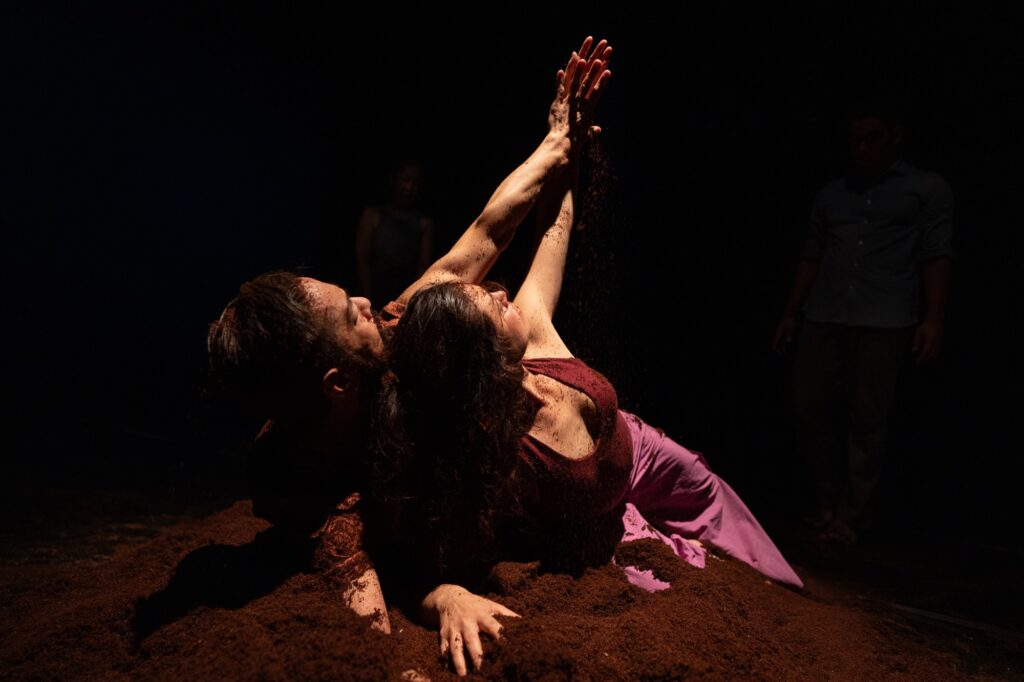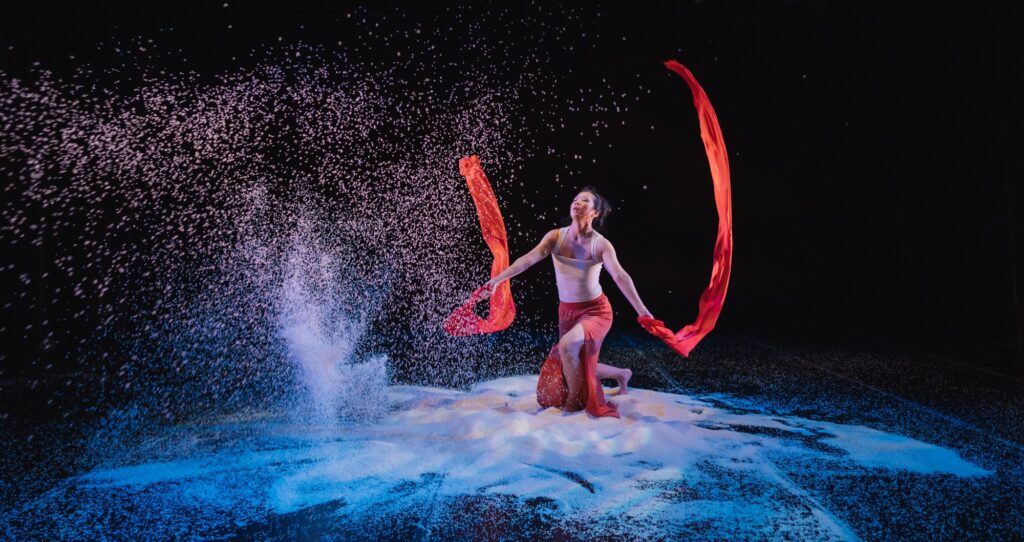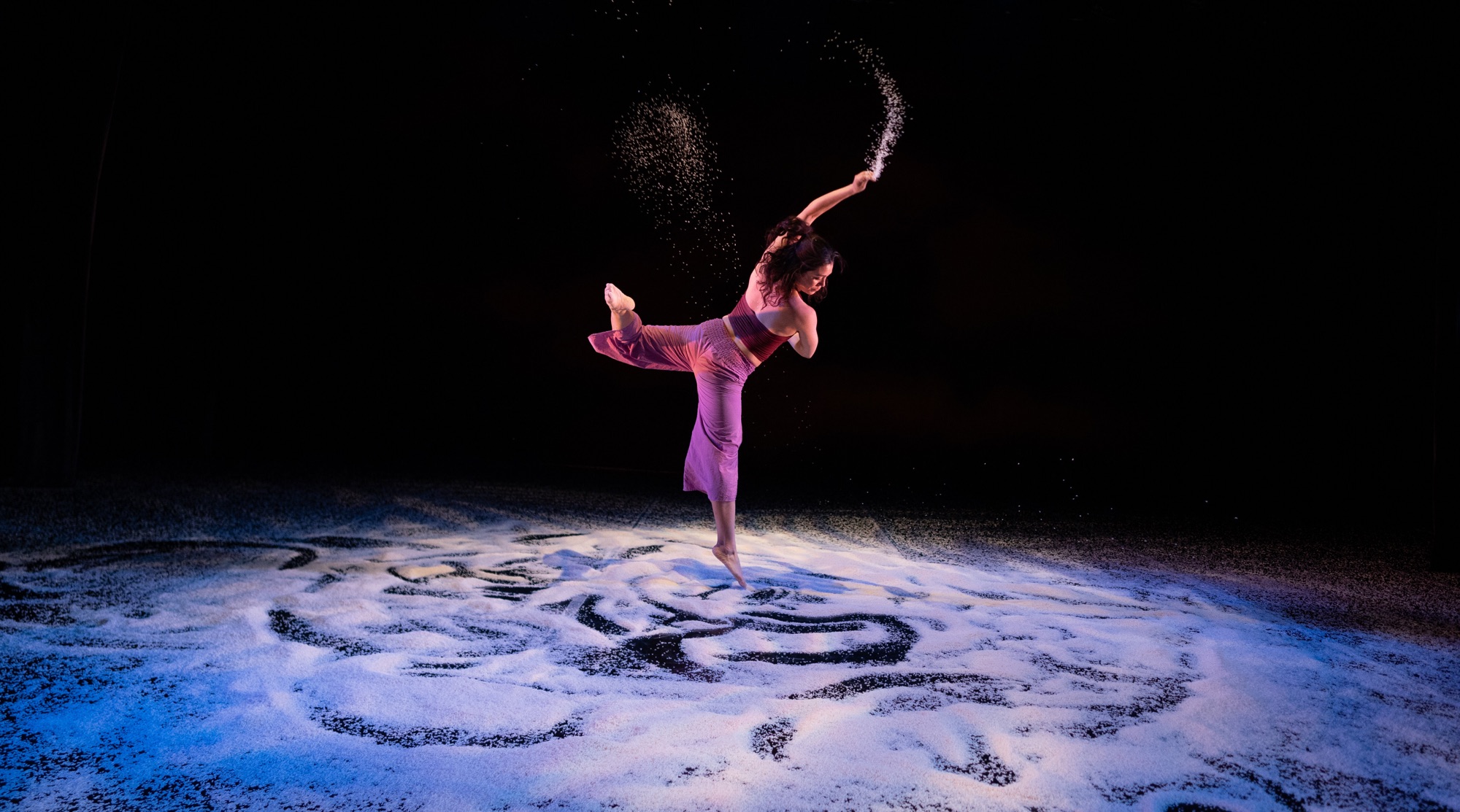Words by Maxine Flasher-Duzgunes.
How might one reach their ancestors – through the kneading of bread, the sifting of rice, the sowing of soil? Coming in passing with heritage always seems to take root in the ground on which we stand, the stories that emerge like crops to be harvested, by many hands from other(ed) lands…Lenora Lee Dance in collaboration with Moyra Silva Rodríguez have sown a unique performance entitled A Bridge to Now / Un Puente hacia el Presente, premiering Friday, March 28 at Dance Mission Theater, that traverses the history of Chinese immigration to Peru and the U.S. and honors the seeds of labor, culture, and tenacity that they have carried across oceans to the communities on both continents that have formed today.
We first learn of “tusán” – Peruvian citizens with Chinese ancestry – from the text that appears on the back wall and the audio from an interview. The words “motherhood” and “abundance” pilot our way into a duet between dancers SanSan Kwan and Catalina O’Connor who often grasp hands interchangeably, one on the floor and one standing and then reversed as if waltzing through an unbroken passage. “Going to Chinatown was a way to learn about ancestry,” plays the recording, in reference to one of the Western Hemisphere’s first Chinatowns in Lima. Soon after, the remaining five dancers emerge and join the duet to form a crowd, the type that forms when you’re standing in line in the market but that quickly devolves into a cluster. To the sounds of waves, each dancer buoys and softly bumps against the others as together they recede backwards. We hear “floating hells that smelled of dirt” to describe the former African slave ships that transported the Chinese overseas to work in Peru’s cotton plantations and Guano mines, a material coming from the excrement of seabirds that was used to produce plant fertilizers, as well as gunpowder. A whiff of dirt wafts through the air as dancer Johnny Huy Nguyen runs it through his hands downstage, yielding to but at the same time embracing the coffee-colored mound. Despite little humanity on the ships, perhaps it was on the earth where the migrants had landed.

Dancer and co-artistic director of the project, Moyra Silva Rodríguez, spirals in and out of the floor, her arms like lifelines guiding each whorled pathway. She dances with signs of strength but also exhaustion, the rise and fall of a current that disrupts even the steadiest of us. Silva Rodriguez, whose Chinese-Peruvian heritage inspired the making of the piece, moves in transience, at some points getting caught in a physical coil and then sliding out to break free. “You are not Peruvian” is overheard in another interview, as historically tusán are not seen as rightful citizens of Peru, calling attention to the many lives within the country whose identities remain in fluctuation.
A playful duel then begins to form between dancers Lynn Huang and José Avilés as the audio conversation moseys between Cantonese and Spanish. José’s gestures are more grounded into the floor, involving a powerful kneel or a roll that returns to her side, and Lynn’s wind and twist like Moyra’s and cut elegantly through upward space. But it’s not long before their movements become one another’s, and the at-first swift back-and-forth languages start to trip and jumble into the other. There is later mention of “Chifa”, a Chinese-Peruvian culinary tradition that draws on Cantonese elements with Peruvian ingredients, starting about one hundred years ago in Lima’s Chinatown and today having spread to neighboring countries. Additional duels erupt and steam between the dancers like the fusing of foods in a wok. Everyone brings a bowl and a pair of chopsticks to the center of the stage and extends their utensil to the sky, sharing a meal as a way to know each other, to trade vegetables as easily as words, to form communion over the gifts of the land.
The opening of a blue fan transforms the palate of the stage, then a red fan and then a sword. At times the fan is waved decorously and at others it is whipped as if in high-spirited combat. In this section, the interviewee details how Chinese dance forms like Kung Fu and Lion Dance have become important cultural traditions in Peru, especially during annual festival celebrations. Movement was another kind of trade, and for many Chinese immigrants who historically didn’t have a voice, artists offered a colorful channel for them to be heard, a parade of changes that was meant to be exchanged and passed down the festive streets of Lima.

The final scenes of the piece pour out like emptied rice from sacks that the dancers attempt to barter with audience members. Pools of rice continuously form and grow wider at various ends of the stage, each dancer drawing patterns with their feet and hands and in unison launching handfuls of rice into the air. With every toss, it scatters and distributes like rapid snowfall or sand in a vial: jewels of the earth. While the ensemble paints the space with speckled white strokes, Moyra approaches the dirt pile which is now peppered with rice and partially covers herself, introducing its aroma once again. Dancer Peter Cheng comes from behind and wipes the dirt off her shoulders, offering her support and guiding her into a series of lifts that suspend, drift, and helix. The words “part of two worlds” stand out from the rest as if an acknowledgement that the rice doesn’t need to be separated from the dirt, that in fact they come from the same place.
Nurturing a seed ground where a rich multicultural identity grows, directors/choreographers Moyra Silva Rodríguez and Lenora Lee have co-created a piece which blends origins with their landing places, and the people onboard the ship to now through an ever-shifting movement, a movement to migrate, a movement to dance, a movement to paint the world.
For tickets to the premiere of A Bridge to Now, visit: https://dancemissiontheater.org/2024/12/27/march-28-30-a-bridge-to-now-un-puente-hacia-el-presente/. Header image: Pictured: Moyra Silva Rodríguez. Photo by Robbie Sweeny.
